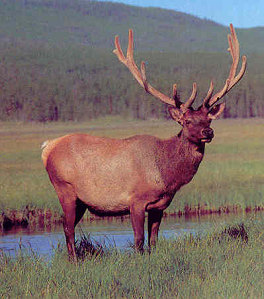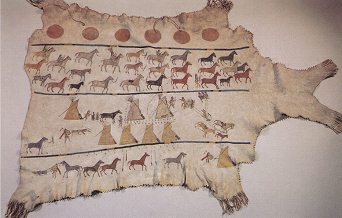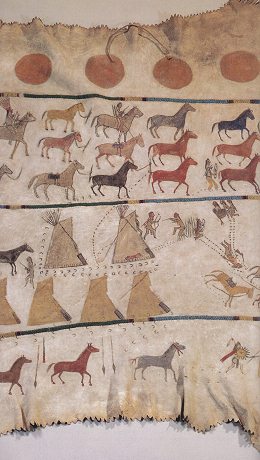from:
Prestel museum guide, text by Denise Daenzer and Tina
Wodiunig: Native Museum of Zurich (orig. German:
Indianermuseum Zürich / Indianermuseum der Stadt Zürich);
Prestel edition; Munich, New York 1996; supported by
Cassinelli Vogel foundation, Zurich, by MIGROS percent for
culture, by Volkart foundation in Winterthur; ISBN
3-7913-1635-4
<Wapiti wall hanging
|

A wapiti stag, here a Rocky Mountain wapiti stag
[1]
Skin of wapiti can be worked out as a fine leather
and then as a wall hanging with picture stories as
it happened here:
|
[Painting on animal skin -
feminine geometric abstract design - masculine painting of
wars and chronicles]
Rock paintings and painting of animal skins were the origin
native painting arts. There were two styles: geometric
abstract figurines and forms preferred by women, and natural
designs painted by men illustrating their war adventures and
chronicles of their tribes. Stylized scenery with men and
animals were telling real events and were directly painted
on the skins - above all on skins of bison, stags and
antelopes, later also on fabrics.
[A horse raid painted on a
leather]
This painted leather telling a horse raid is a rare peace
because at the beginning of 19th century the wapitis - which
are related with European red deer - had withdrawn to the
Rocky Mountains, and there they were only rarely hunted by
Prairie Natives. The skin of the presented peace here is
parted in four levels by three ribbons in beading technique.
The first level above shows six red discs as an indication
of time representing suns during the night, so they are
representing moons, because a horse raid was executed always
during the night. In the second level is already shown the
final action of the horse raid - the thieves are driving
home the robbed horses. The third level shows the horse
thieves in different fights, and the fourth level shows the
actions of the skin owner himself.
[Tanning the skin with fat]
This skin is tanned without tanbark. This means that it's
tanned in the way of fat tanning (chamois). A paste of a
mixture of brain, fat and liver is spread on the skin and
then one lets move into the skin. After this the leather is
wrapped around a wet bundle of grass and after some days the
leather will be wronged out and will be cleaned with a
leather scraper tool getting a very soft leather (p.83).
Painted leather of a wapiti stag with the illustration of a horse raid
Painted leather of a wapiti stag with the illustration of a horse raid, zoom






